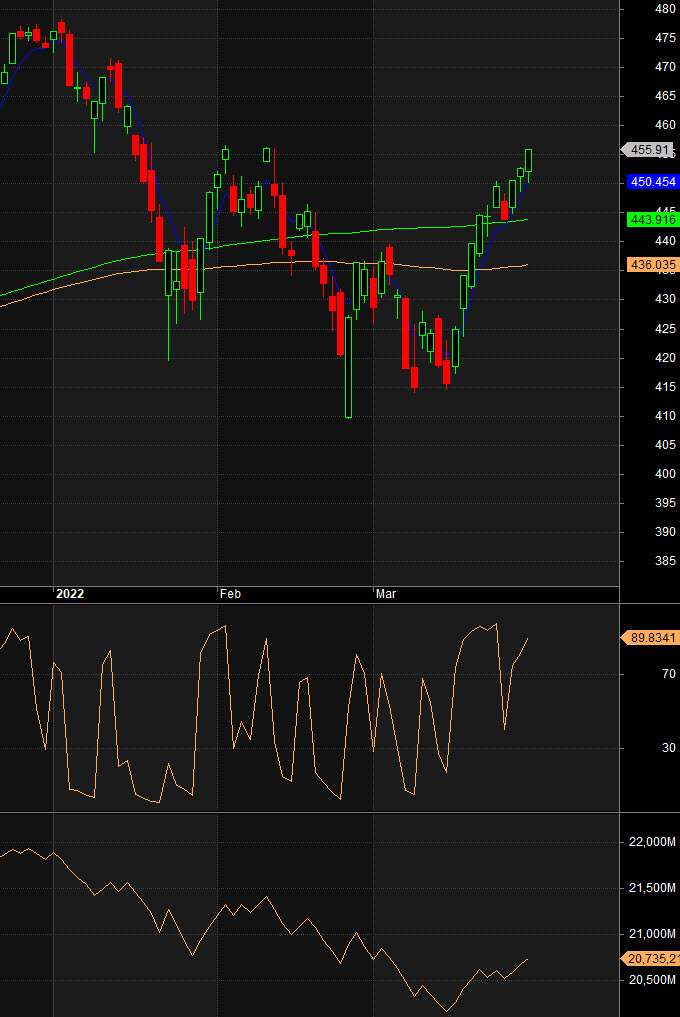Today is 3/29/22 and the market has opened up with even more impressive gains – making it appear as though we will indeed close out the month far enough above the long term moving averages in a few days to return to a full weight in equities.

As can be seen, the market has been almost unidirectionally up since 3/14/22 – which gives almost zero trading opportunity for mean reversion trading strategies.
That is why the portfolios don’t depend 100% on mean reversion strategies, although trend following expectations should be tempered due to the fact that we’ve been at reduced exposure due to the drop below the long term moving averages.
I expect the portfolios to go back to full weight trend following at the end of the month barring a strong sell off – but I’m going to outline some heavy reasons why I think the market is actually in a very risky place going forward that I don’t think the mainstream financial press is fully appreciating.
The big risk facing the market is inflation. We can see the direct impact on the portfolios on all the bond positions being pushed into short duration and/or TLT (20 year inflation protected bond) positions for weeks now. With “transitory” removed from the Fed language, and Producer prices up 10% year over year as of February, we have some real problems.
The last time the Fed tried to raise interest rates, they never got higher than 2.5% before they had to cry “uncle”, and it is HIGHLY unlikely that they will ever get that high in this rate rising cycle – the economy is simply too weak for that and we have way more debt than we do the last time we tried.
What is far more likely to happen is that as rates start to rise, the economy will quickly start to suffer: Look for rising mortgage costs, decreasing values of real estate, fewer new home starts, a slow down in new hires in the general economy – in other words – STAGFLATION. Another word of warning – in what world has inflation EVER been fought to a standstill when real rates have been lower (i.e. still inflationary) than the current rate of inflation? Answer: NEVER.
This is going to be a huge problem – and the market is going to be in for a huge shock when investors finally realize the Fed is powerless to fight inflation.
The second major risk facing the markets is coming food shortages. The three major industrial components our farming industry needs to produce are fertilizer, diesel fuel, and Liquified Natural Gas (LNG). All three of these are facing simultaneous massive disruption and/or supply chain issues at the same time.
Farmers are facing a 300% increase in fertilizer costs from 2 years ago – and while they can skimp for 1 year, doing so creates a multi-year problem that is very difficult to recover from.
Diesel prices have also skyrocketed with the worldwide rise in oil prices reaching record prices earlier this year.
Compounding both of these problems are supply chain issues that keep both parts and labor in short supply – a malfunctioning but hard to find sensor can keep a $250K tractor out of commission.
Finally – the war in Ukraine is pushing the US to make up lost LNG production in Europe from US production – but guess which industry in the US is MOST dependent on LNG? That’s right, the farming industry. The US currently has a 35 day supply of LNG – is that enough to meet the needs of Europe torn by war and cut off from Russian energy and supply food production in the US?
Whether you agree with this analysis or don’t the important thing to know is that while I have these opinions and am willing to share them, I trade from quantitative, backtested strategies ONLY.
This sort of analysis is useful to gain insight for strategy creation, testing and enhancement, but is never sufficient for trading in and of itself.
In future posts look for an end of quarter update I will share how both portfolios did, I will begin a series of discussions on what it takes to actually do valid financial research that you can trust.
